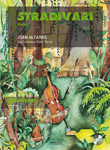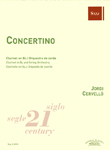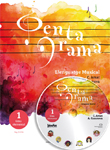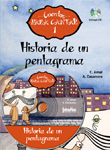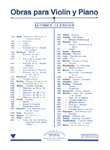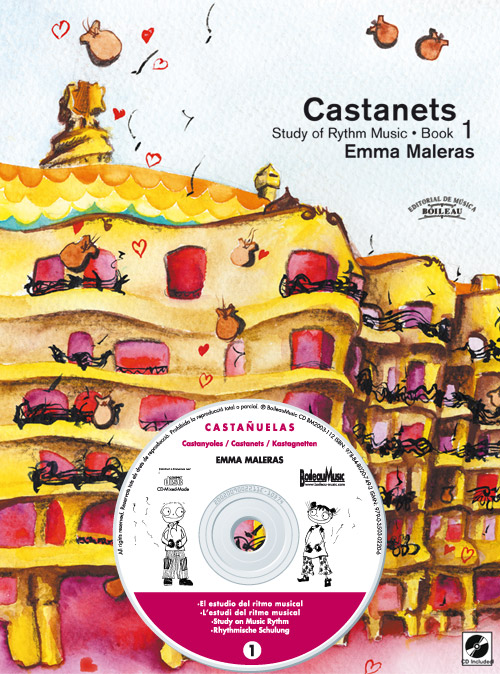CASTANETS - Book 1
The study of musical rhythm
Castañuelas
MALERAS, EmmaReg.: B.3336
21,00 €
P.V.P. (VAT included 4%)
Add to cart
- Review: GRAU, Consol
- Ensemble: Solo.
- Genres: Musical education: Instrumental study repertoire; Instrument methods.
- Language: Inglés
- Product format: Partituras + CD / DVD
- Difficulty level: Elementary
- Period: 2nd half S. XX - XXI
- Publishing house: Editorial Boileau
- Collection: Maleras
- Illustrator: FORNER, Ester
- No. of pages: 44
- Measure: 29,50 x 21,00 cm
- ISBN: 978-84-8020-751-5
- ISMN: 979-0-3503-0224-4
- Available in digital: No
- Available for rent: No
There is no doubt that Emma Maleras knows a great deal about everything to do with the study of rhythm. Having learned music by first studying the piano and then, in particular, by studying flamenco dance and learning to play the castanets, she has spent more than thirty years of her career teaching the castanets to several generations of pupils.
This extensive experience has helped her to create a teaching method that she has perfected throughout her teaching career. She now presents her method in this series of books, the aim of which is for pupils to achieve true rhythmic accuracy through their reading, as a separate discipline from learning to play an instrument in tune.
Due to their small size and sharp, dry sound, castanets are ideal for studying rhythm and they have proved to be useful for beginners of all ages.
By practising with these books pupils will gradually learn how rhythm works, studying aspects such as accents, measures, the values of notes and rests, as well as syncopation and tied notes. Pupils will get used to the different beats on which to come in: in time, off beat, on the up-beat and acephalous. All the studies and exercises in the collection are accompanied by music by classical composers and popular tunes, which make it enjoyable and pleasant to practise, despite the slow metronome beat that is used during the earlier lessons. These accompaniments are included on the Audio CD that comes with the book.
It is also very useful for Dance students to play the castanets, as it will quickly help them to learn the necessary accuracy of movement that this discipline requires. Instrumentalists in general will also gain a great deal from studying the castanets, as they strengthen the fingers due to the movement of the 3rd finger, as well as giving the ring finger and little finger considerable independence. Constant castanet work also has proven therapeutic properties, both as a prevention and as a cure.
In short, this method, which has been created and developed by Emma Maleras, helps to raise the profile of the castanets and emphasises all their benefits for music students, as well as promoting the beauty of their sound as a solo instrument, which is admired all over the world.
Initiation to understand the musical writing of castanets
the bigram
numbering of the fingers
The 3rd and 7th fingers
music theory and notions of musical language
note values
pauses or rests
time signatures time signatures
The castanets and you, use and sustain of the instrument
position for studying nota notations pesantes
Eleven daily exercises with nota notated weights
The 2/4 time signature
practice of the metrical accent of the 2/4 time signature
five exercises for practising the metrical accent of time signature 2/4
White exercise in 2 beat time signature
Work no. 1 (practice of crotchets and crotchets in 2/4 time): La pastorcilla and El baile de San Ferriol (The little shepherdess and The dance of San Ferriol)
4/4 time signature
Practice of the metrical accent of the 4/4 time signature
Five exercises for practising the metrical accent in 4/4 time signature
Exercise for practising the round notes
Exercise for practising the half notes in 4/4 time signature
Work no. 2 (practice of the 4 beats that are equivalent to the semibreve): Sonatina op. 36 no. 1
The 3/4 time signature
Metric accent in 3/4 time
Six exercises for practising the metrical accent of the 3/4 time signature
Piece no. 3 (practice of half notes and quarter notes in 3/4 time): Mazurka op. 7 n. 1
The coda
Piece no. 4 (practice of half notes and quarter notes in 2/4 time with finger changes on the crotchets): Anna-Polka op. 117
Piece no. 5 (practice of half notes and quarter notes in 2/4 time with a change of the number of fingers): with joy all over the world
The dotted dot
Exercise for practising minims with dotted notes
Two exercises in 4/4 time signature with various figures
Work no. 6 (practice of half notes, dotted minims and crotchets): minuet
The calderón
Piece no. 7 (practice of all the values learnt in this book): gavotte
Estefania

